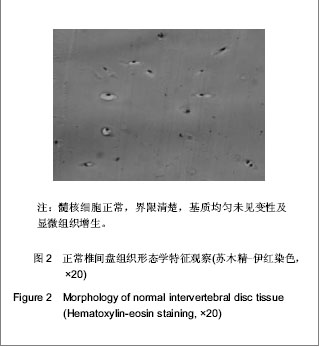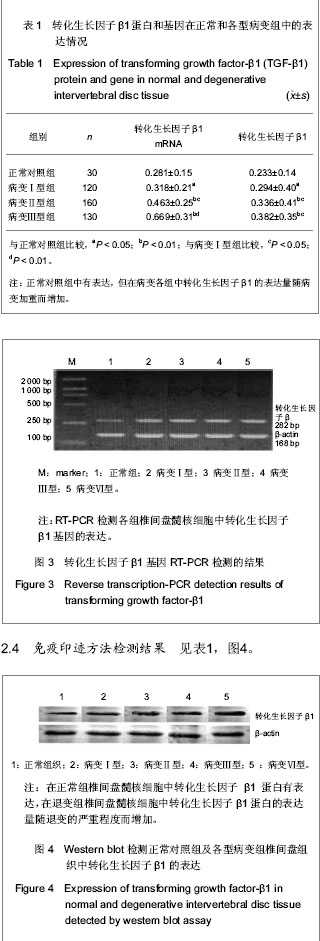| [1] Gembun Y,Nakayama Y,Shirai Y,et al.Surgical results of lumbar disc herniation in the elderly.J Nippon Med Sch.2001; 68(1):50-53.http://www.ncbi.nlm.nih.gov/pubmed/11180701[2] Boos N,Weissbach S,Rohrbach H,et al.Classification of agerelated changes in lumbar intervertebral disca 2002 volvo Award in basic science.Spone.2002;27(2):2631-2644.http://www.ncbi.nlm.nih.gov/pubmed/12461389[3] Antoniou J,Pike GB,Steffen T,et al.Quantitative magnetic resonance imaging in the asseaament of degene rative disc disease.Magn Reson Med.1998;40(8):900-907.http://www.ncbi.nlm.nih.gov/pubmed/9840835[4] Ma L,Zwahlen RA,Zheng LW,et al.Influence of nicotine on the biological activity of rabbit osteoblasts.Clin Oral Implants Res. 2011;22(3):338-342.http://www.ncbi.nlm.nih.gov/pubmed/21561475[5] Kim IS,Song YM,Hwang SJ.Osteogenic reaponses of human mesenchymal stromal cell to static stretch.J Dent Res.2010; 89(10):1129-1134.http://www.ncbi.nlm.nih.gov/pubmed/20639509[6] Bettina K,Tao Y,Elda M,et al.Interraction of TGF-B and BMP signaling pathways during chondrogenesis.Plos One.2011; 6(1):1-9.http://www.ncbi.nlm.nih.gov/pubmed/21297990[7] Wang Y, Yu SY, Gao XJ, et al. Dongwuxue Zazhi. 2010;45(3): 127-132.王悦,俞诗源,高先军,等.Bax,TGF-B1和Ghrelin在饥饿后长耳鸪胃及小肠中的免疫组织化学[J].动物学杂志,2010,45(3): 127-132.http://www.cnki.com.cn/Article/CJFDTotal-GWSX200102002.htm[8] Hu YG. Beijing: The Publishing House of People′s Health. 2004: 411.胡有谷.腰椎间盘突出症[M].第三版,北京:人民卫生出版社,2004: 411.[9] Nomura T,Mochida J,Okuma M,et al.Nuclus pulposus allograft vetards intervertebral disc degeneration.Spine. 2001;38(1): 94-101.http://www.ncbi.nlm.nih.gov/pubmed/11501830[10] Yang H,wu J,Liu J et al.transplanted mesenchymal stem cells with pure fibrinous gelatin-transforming growth factor-betal decrease rabbit intervertebral disc degeneration.Spine J.2010; 10(9):802-810.http://www.ncbi.nlm.nih.gov/pubmed/20655810[11] Delamarter R, Zigler JE, Balderston RA, et al. Prospective, random- ized, multicenter Food and Drug Administration investigational device exemption study of the ProDisc-L total disc replacement compared with circumferential arthrodesis for the treatment of two-level lumbar degenerative disc disease: results at twenty-four months. J Bone Joint Surg (Am).2011;93(8):705-715.http://www.doc88.com/p-8095953936365.html[12] Gao CH, Lv M, Yang C, et al. Jizhu Waike Zazhi. 2012;10(6): 371-373.高春华,吕明,杨诚,等. 椎间盘内注射转化生长因子-β1诱导椎间盘退变[J]. 脊柱外科杂志,2012,10(6):371-373.http://www.cnki.com.cn/Article/CJFDTotal-JZWK201206017.htm[13] Li GF, Zhang SK, Fu CF, et al. Zhongguo Zuzhi Gongcheng Yanjiu yu Linchuang Kangfu. 2009;13(2):359-362.李高峰,张绍昆,付长峰,等. 细胞因子及基因治疗椎间盘退行性变的研究动态[J]. 中国组织工程研究与临床康复,2009,13(2): 359-362.http://www.cnki.com.cn/Article/CJFDTotal-XDKF200902046.htm[14] Yan JW, Li AG, CHen HH, et al. ZHonguo Jiaoxing Waike Zazhi. 2012;20(24):2268-2271.闫军伟,李爱国,陈鸿辉,等. 炎性细胞因子在椎间盘退变中的研究进展[J]. 中国矫形外科杂志,2012,20(24):2268-2271.http://www.cnki.com.cn/Article/CJFDTotal-ZJXS201224025.htm[15] Bobick BE,Kulyk WM. Regulation of cartilage formation and maturation by mitogen-activated protein kinase signaling.Birth Defects Res C Embryo Today.2008;84(2):131-154.http://www.ncbi.nlm.nih.gov/pubmed/18546337[16] Guo Q, Jiang XF, Chen Y, et al. Zhongguo Zuzhi Huaxue ji Xibao Huaxue Zazhi. 2012;21(1): 69-73.郭琼,姜孝芳,陈艳,等.TGF-B1及其受体在大鼠整胚及软骨雏形发育过程中的表达[J].中国组织化学及细胞化学杂志,2012, 21(1): 69-73.http://www.cnki.com.cn/Article/CJFDTotal-GGZZ201201015.htm[17] Mon SH,Nishida K,Gilbertson LG,et al.Biologicresponse of human intervertebral disc cells to gene therapy cocktail. Spine.2008;33(17):1850-1855.http://www.ncbi.nlm.nih.gov/pubmed/18622355[18] Hu BS, Xu XJ, Guo YL, et al. Zhongguo Zuzhi Gongcheng Yanjiu. 2013;17(4):571-575.胡宝山,许喜筠,郭元利, 等. 各种腰椎间盘细胞可否自分泌产生白细胞介素1β[J]. 中国组织工程研究,2013,17(4):571-575.http://www.cnki.com.cn/Article/CJFDTotal-XDKF201304007.htm[19] Cheng SQ, Chen GB, Liu YH, et al. Hebei Yixue. 2013;19(2): 270-272.成善泉,陈国邦,刘亿华,等. 椎间盘退变的形态学分型中转化生长因子-β1表达的临床意义[J]. 河北医学,2013,19(2):270-272.http://www.cnki.com.cn/Article/CJFDTotal-HCYX201302047.htm[20] SinghKM,MasodaKM.ThonarE.et al.Agerelated charges in the wxtracellularmatrix ofnucleus pulposus and annulus fibrosus of human intervertebral disc.Spino.2009;34(1):10-16.http://www.ncbi.nlm.nih.gov/pubmed/12193991[21] Yang Y,He XF,Li YH,et al.Association of transforming growth facto-B1 with pathological grading of intervertebral disc degeneration.Article in Chinese.2012;32(6):897-900.http://www.ncbi.nlm.nih.gov/pubmed/22699080[22] Karamboulas K,Dranse HJ,Underhill TM.Regulation of BMP dependent chondrogenesis in early limb mesenchyme by TGF beta signals.Cell Sci.2010;123(12):2068-2076.http://www.ncbi.nlm.nih.gov/pubmed/20501701[23] Baldridqe D,Shchelochkov O,Kelley B,et al.Signaling pathways in human skeletal dysplasias.Annu Res Genomics Hum Genet.2010;2991(1):189-217.http://www.ncbi.nlm.nih.gov/pubmed/20690819[24] Song QX, Wu Y, Chen YZ.Zhongguo Yaoli Tongbao.2011; 27(3):378-382.宋清晓,吴勇,陈元仲.CD44抗体H144a对急性髓系白血病学报株HL-60细胞体外增值分化作用的研究[J].中国药理通报,2011, 27(3):378-382.http://www.doc88.com/p-605272455634.html[25] Heldin CH,Landstrom M,Moustakas A.Mechanism of TGF-beta signaling t growth arrest apoptosis and epithelial-mesenchymal transtion.Curr Opin Cell Biol.2009; 21(2):166-176.http://www.ncbi.nlm.nih.gov/pubmed/19237272[26] Li J, Yang SH, Zhao ZW.Zhongguo Linchuang Kangfu.2003; 7(14):2079-2080.李进,杨述华,沼增务.细胞因子与椎间盘退行性变的关系[J].中国临床康复,2003,7(14):2079-2080.http://www.cnki.com.cn/Article/CJFDTotal-XDKF200314048.htm[27] Cui D,Zhang S,Ma J,et al.Short in terfering RNA targetting NF-kappa B induces apoptosis of hepatic stellate cells and attenuates extracellular matrix produetion.Dig Liver Dis. 2010;42(11):813-817.http://www.ncbi.nlm.nih.gov/pubmed/20409762[28] Sing KM,Masuda KM,Thonar E,et al.Age-related changes in the extracellular matrix of nucleus pulposus and anulus fibrosus of human intervertebral disc.J Spine 2009;1(34): 10-16.http://www.ncbi.nlm.nih.gov/pubmed/19127156[29] Xu JW,Zhong YM,Ji J,et al.Associations of transforming growth factor beta 1-509c/T site gene polymorphism with blood stasis syndrome of lumbar intervertebral dise protrusion and intervertebral dusc degeneration.J Clin Rehabil Tissue Eng Res.2010;24(21):4524-4527.http://d.wanfangdata.com.cn/Periodical_xdkf201024040.aspx[30] Lin W, Wang WM, Zhuang YF, et al. Zhongguo Zuzhi Gongcheng Yanjiu yu Linchuang Kangfu. 2009;13(37): 7309-7313.林旺,王万明,庄颜峰,等.胰岛素样生长因子1,血血小板源性生长因子,转化生长因子β1对人退变纤维环细胞生物活性的影响[J].中国组织工程研究与临床康复,2009,13(37):7309-7313.http://www.cnki.com.cn/Article/CJFDTotal-XDKF200937032.htm[31] Xu JW,Zhong YM,Ji J,et al.Associations of transforming growth factor bata1-509C/T site gene polymorphism with blood stasis syndrome of lumbar intervertebral disc protrusion and intervertebral disc degeneration. J Clin Rehabil Tissue Eng Res.2010;24(12):4524-4527.http://d.wanfangdata.com.cn/Periodical_xdkf201024040.aspx[32] Abbott RD,Purmessur D,Monsey RD,et al.Regenerative potential of TGF-B+Dex and notochordal cell conditioned media on degenerated human intervertebral disc cell.Jorthop Res.2012;30(3):482-488.http://www.ncbi.nlm.nih.gov/pubmed/21866573[33] Hegewald AA,Endres M,Abbushi A,et al.Adequacy of herniated disc tissue as cell source for nucleus pulposu reqeneration. J Neurosurg Spine.2011;14(2):273-280.http://www.ncbi.nlm.nih.gov/pubmed/21214312[34] Liu Y,Li JM,Hu YG.Transplantation of gene modified nucleus pulposus cells reverses rabbit intervertebral disc degeneration.Chin Med J (ENG1).2011;124(16):2431-2437http://www.ncbi.nlm.nih.gov/pubmed/21933582[35] He B, Yang J, Peng FL, et al.Xibao yu Fenzi Mianyixue Zazhi, 2012; 28(2):197-199.何斌,杨坚,彭方亮,等.退变髓核细胞与正常髓核细胞体外培养的生物学特性比较[J].细胞与分子免疫学杂志,2012,28(2): 197-199.http://www.cnki.com.cn/Article/CJFDTOTAL-XBFM201202028.htm[36] Serigan K,Sakai D,Hiyama A,et al.Effector cell number on mesenchymal stem cell transplantatin in a canine disc degenration mode.Orthop Res.2010;28(10):1267-1275.http://www.ncbi.nlm.nih.gov/pubmed/20839317[37] Gerald W.Apoptotic and non-apoptotic programmed cardiomyocyte death in ventricular remodelling.Cardiovasc Res.2009;81(3):465-473.http://www.ncbi.nlm.nih.gov/pubmed/18779231[38] Feng G,Zhao X,Liu H,et al.Transplantation of masenchymal stem cells and nucleus pulposus cells in a degenerative disc model in rabbits:a comparison of cell types as potential candidates for disc regeneration.J Neurosurg Spine. 2011; 14(3):322-329.http://www.ncbi.nlm.nih.gov/pubmed/21250814[39] Gerald W. Apoptotic and non-apoptotic programmed cardiomyocyte death in ventricular remodelling.Cardiovasc Res.2009;81(3):465-473.http://www.ncbi.nlm.nih.gov/pubmed/18779231[40] Shi YY, Dong X, Shi YH, et al. Zhongguo Bingli Shengli Zazhi. 2009;25(4):802-805.石永英,董颀,石永华,等.TGF-β1对体外培养的大鼠心肌细胞肥大和凋亡的影响[J].中国病理生理杂志,2009,25(4):802-805.http://www.cnki.com.cn/Article/CJFDTotal-ZBLS200904047.htm[41] Dobaczewski M,Chen W,Frangogiannis NG. Transforming growth factor (TGF)-B signaling in cardiac remodeling.J Mol Cell Cardiol.2011;51(4):600-606.http://www.ncbi.nlm.nih.gov/pubmed/22505689 |



